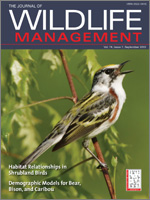To provide habitat for late-successional wildlife species, new ecosystem-based forest management practices aim to retain elements of complex stand structure, including live residual trees, dead wood legacies, and advanced regeneration, within managed stands. Predicting the effectiveness of these strategies is a challenge for species whose habitat relationships may involve multiple factors and can vary among sites. For 2 years, we live-trapped a common, late-successional microtine rodent, the southern red-backed vole (Myodes [formerly Clethrionomys] gapperi), in 40 1.4-ha boreal mixedwood sites in Ontario, Canada. Using a neighborhood-scale modeling approach, we related red-backed vole capture locations to spatially referenced measures of overstory trees, shrubs and saplings, downed woody debris (DWD), and forest floor substrate. We further assessed how associations with these features varied with availability of the features within a site and as a function of stand management history. In spring, red-backed voles were associated with trap stations that had, within a 26-m radius, a dense shrub layer, abundant late-decay DWD, coniferous understory and litter, and possibly, understory vegetation associated with moist conditions. Positive associations with shrub cover, late-decay DWD, and a moisture-associated understory were most apparent in sites in which these elements were scarce (e.g., <1,500 stems/ha of hardwood saplings and short shrubs; <0.8% projected ground cover of late-decay DWD). The importance of late-decay DWD; shade-tolerant, coniferous understory composition; and substrate varied depending on a site's management history, with each feature having a strong positive effect in 47–64-year-old stands that were harvested using horse skidding and weaker effects in both 31–40-year-old stands that were clearcut with mechanical skidding and >80-year-old fire-origin stands. Our models of fine-scale habitat relationships for red-backed voles may be useful in establishing structural retention guidelines suitable for wildlife species dependent on late-successional habitat structure. In this regard, retaining abundant DWD and 10–30% live trees at harvest may be effective management strategies for providing favorable habitat conditions at localized scales.
How to translate text using browser tools
1 September 2010
Fine-Scale Habitat Associations of Red-Backed Voles in Boreal Mixedwood Stands
Mark C. Vanderwel,
Jay R. Malcolm,
John P. Caspersen,
Mark A. Newman
ACCESS THE FULL ARTICLE
It is not available for individual sale.
This article is only available to subscribers.
It is not available for individual sale.
It is not available for individual sale.
boreal forest
Clethrionomys
ecosystem management
habitat thresholds
Myodes gapperi
neighborhood modeling
Ontario





